Liberal Party of Australia
Liberal Party of Australia | |
|---|---|
WA | |
| House of Representatives | 40 / 151 [note 1] |
| Senate | 25 / 76 [note 2] |
| State and territorial governments | 1 / 8 |
| State and territorial lower house members | 165 / 455 |
| State upper house members | 41 / 155 |
| Website | |
| www | |
The Liberal Party of Australia is a centre-right political party in Australia.[28] The party is one of the two major parties in Australian politics, the other being the Australian Labor Party. The Liberal Party was founded in 1944 as the successor to the United Australia Party. Historically the most successful political party in Australia's history, the party is now in opposition at a federal level and does not hold government in any Australian state or territory with the exception of the island state of Tasmania.[29]
The Liberal Party is the dominant partner in the Coalition with the National Party of Australia. At the federal level, the Liberal Party has been in coalition with the National Party (under various names) since 1949.[30] The Coalition was most recently in power from the 2013 federal election to the 2022 federal election, forming the Abbott (2013–2015), Turnbull (2015–2018) and Morrison (2018–2022) governments. The current party leader is Peter Dutton, who replaced former prime minister Scott Morrison as leader after the Coalition's defeat at the 2022 federal election.
The Liberal Party has a federal structure, with
, and in both the ACT and Northern Territory.The party's ideology has been referred to as conservative,[32] liberal-conservative,[33] conservative-liberal,[34] and classical liberal.[35] The Liberal Party tends to promote economic liberalism and social conservatism.[36] Two past leaders of the party, Sir Robert Menzies and John Howard, are Australia's two longest-serving Prime Ministers.
History
| Protectionist (1887) | Anti-Socialist (1887) | ||||||||||||||||||||||||||||||||||||
| Labor (1901) | |||||||||||||||||||||||||||||||||||||
| Liberal (1909) | |||||||||||||||||||||||||||||||||||||
| National Labor (1916) | |||||||||||||||||||||||||||||||||||||
| Nationalist (1917) | |||||||||||||||||||||||||||||||||||||
| Australian (1929) | |||||||||||||||||||||||||||||||||||||
| United Australia (1931) | All for Australia League (1931) | ||||||||||||||||||||||||||||||||||||
| Liberal (1944–present) | |||||||||||||||||||||||||||||||||||||
Party Foundation
The Liberals' immediate predecessor was the
The UAP had been formed as a new conservative alliance in 1931, with Labor defector Joseph Lyons as its leader. The stance of Lyons and other Labor rebels against the more radical proposals of the Labor movement to deal the
From 1942 onward Menzies had maintained his public profile with his series of "The Forgotten People" radio talks—similar to Franklin D. Roosevelt's "fireside chats" of the 1930s—in which he spoke of the middle class as the "backbone of Australia" but as nevertheless having been "taken for granted" by political parties.[40][41]
Menzies called a conference of conservative parties and other groups opposed to the ruling Australian Labor Party, which met in Canberra on 13 October 1944 and again in Albury, New South Wales in December 1944.[6][7][8] Outlining his vision for a new political movement, Menzies said:
... [W]hat we must look for, and it is a matter of desperate importance to our society, is a true revival of liberal thought which will work for social justice and security, for national power and national progress, and for the full development of the individual citizen, though not through the dull and deadening process of socialism.
— Robert Menzies[42]
The formation of the party was formally announced at
In New South Wales, the
Menzies Era
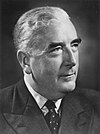
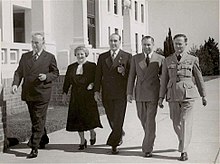
After an initial loss to Labor at the 1946 election, Menzies led the Liberals to victory at the 1949 election, and the party stayed in office for a record 23 years— the longest unbroken run ever in government at the federal level. Australia experienced prolonged economic growth during the post-war boom period of the Menzies government (1949–1966) and Menzies fulfilled his promises at the 1949 election to end rationing of butter, tea and petrol and provided a five-shilling endowment for first-born children, as well as for others.[45] While himself an unashamed anglophile, Menzies' government concluded a number of major defence and trade treaties that set Australia on its post-war trajectory out of Britain's orbit; opened up Australia to multi-ethnic immigration; and instigated important legal reforms regarding Aboriginal Australians.
Menzies was strongly opposed to Labor's plans to nationalise the Australian banking system and, following victory at the 1949 election, secured a double dissolution election for April 1951, after the Labor-controlled Senate rejected his banking legislation. The Liberal-Country Coalition was returned with control of the Senate. The Government was re-elected again at the 1954 election; the formation of the anti-Communist Democratic Labor Party (DLP) and the consequent split in the Australian Labor Party early in 1955 helped the Liberals to secure another victory in December 1955. John McEwen replaced Arthur Fadden as leader of the Country Party in March 1958 and the Menzies-McEwen Coalition was returned again at elections in November 1958—their third victory against Labor's H. V. Evatt. The Coalition was narrowly returned against Labor's Arthur Calwell in the December 1961 election, in the midst of a credit squeeze. Menzies stood for office for the last time at the November 1963 election, again defeating Calwell, with the Coalition winning back its losses in the House of Representatives. Menzies went on to resign from parliament on 26 January 1966.[46]
Menzies came to power the year the
In 1951, during the early stages of the
In 1956, a committee headed by Sir Keith Murray was established to inquire into the financial plight of Australia's universities, and Menzies injected funds into the sector under conditions which preserved the autonomy of universities.
Menzies continued the expanded immigration program established under Chifley, and took important steps towards dismantling the
Menzies retired in 1966 as Australia's longest-serving Prime Minister.
Holt government

Harold Holt replaced the retiring Robert Menzies in 1966 and the Holt government went on to win 82 seats to Labor's 41 at the 1966 election.[54] Holt remained prime minister until 19 December 1967, when he was declared presumed dead two days after disappearing in rough surf in which he had gone for a swim. His body has never been found.
Holt increased Australian commitment to the growing
Gorton government

The Liberals chose John Gorton to replace Holt. Gorton, a former World War II Royal Australian Air Force pilot, with a battle scarred face, said he was "Australian to the bootheels" and had a personal style which often affronted some conservatives.
The
Gorton maintained good relations with the United States and Britain, but pursued closer ties with Asia. The Gorton government experienced a decline in voter support at the 1969 election. State Liberal leaders saw his policies as too centralist, while other Liberals didn't like his personal behaviour. In 1971, Defence Minister Malcolm Fraser, resigned and said Gorton was "not fit to hold the great office of Prime Minister". In a vote on the leadership the Liberal Party split 50/50, and although this was insufficient to remove him as the leader, Gorton decided this was also insufficient support for him, and he resigned.[56]
McMahon government and Snedden leadership

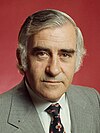
Former treasurer William McMahon replaced Gorton as prime minister. Gorton remained a front bencher but relations with Fraser remained strained.
The economy was weakening. McMahon maintained Australia's diminishing commitment to Vietnam and criticised Opposition leader, Gough Whitlam, for visiting Communist China in 1972—only to have the US President Richard Nixon announce a planned visit soon after.[57]
During McMahon's period in office,
The
Billy Snedden led the party against Whitlam in the 1974 federal election, which saw a return of the Labor government. When Malcolm Fraser won the Liberal Party leadership from Snedden in 1975, Gorton walked out of the Party Room.[60]
Fraser years
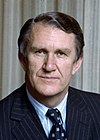
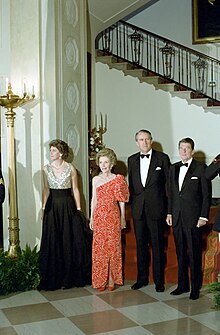
Following the 1974–75
Fraser maintained some of the social reforms of the Whitlam era, while seeking increased fiscal restraint. His majority included the first Aboriginal federal parliamentarian, Neville Bonner, and in 1976, Parliament passed the Aboriginal Land Rights Act 1976, which, while limited to the Northern Territory, affirmed "inalienable" freehold title to some traditional lands. The Fraser government also established the multicultural broadcaster SBS,[61] accepted Vietnamese refugees, opposed minority white rule in apartheid South Africa and Rhodesia and opposed Soviet expansionism, but Liberal minister Don Chipp split off from the party to form a new centrist-social liberal party, the Australian Democrats in 1977.
The Liberals under Fraser won substantial majorities at the
Opposition (1983–1996)

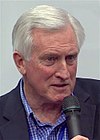

A period of division for the Liberals followed, with former Treasurer
Howard government

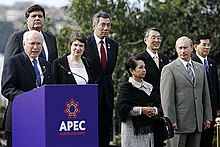
Labor's Paul Keating lost the 1996 Election to the Liberals' John Howard. The Liberals had been in Opposition for 13 years.[64] With John Howard as prime minister, Peter Costello as treasurer and Alexander Downer as foreign minister, the Howard government remained in power until their electoral defeat to Kevin Rudd in 2007.
Howard generally framed the Liberals as being conservative on social policy, debt reduction and matters like maintaining Commonwealth links and the American Alliance but his premiership saw booming trade with Asia and expanding multiethnic immigration. His government concluded the
Howard differed from his Labor predecessor Paul Keating in that he supported traditional Australian institutions like the
In the 2004 Federal elections the party strengthened its majority in the Lower House and, with its coalition partners, became the first federal government in twenty years to gain an absolute majority in the Senate. This control of both houses permitted their passing of legislation without the need to negotiate with independents or minor parties, exemplified by industrial relations legislation known as WorkChoices, a wide-ranging effort to increase deregulation of industrial laws in Australia.
In 2005, Howard reflected on his government's cultural and foreign policy outlook in oft repeated terms:[65]
When I became Prime Minister nine years ago, I believed that this nation was defining its place in the world too narrowly. My Government has rebalanced Australia's foreign policy to better reflect the unique intersection of history, geography, culture and economic opportunity that our country represents. Time has only strengthened my conviction that we do not face a choice between our history and our geography.
— John Howard
The 2007 federal election saw the defeat of the Howard federal government, and the Liberal Party was in opposition throughout Australia at the state and federal level; the highest Liberal office-holder at the time was Lord Mayor of Brisbane Campbell Newman. This ended after the 2008 Western Australian state election, when Colin Barnett became Premier of that state.
State and territory level up to 2007
At the state level, the Liberals have been dominant for long periods in all states except Queensland, where they have always held fewer seats than the
In South Australia, initially a Liberal and Country Party affiliated party, the
The dual aligned Country Liberal Party governed the Northern Territory from 1978 to 2001.
The party has held office in Western Australia intermittently since 1947. Liberal Richard Court was Premier of the state for most of the 1990s.
In New South Wales, the Liberal Party has not been in office as much as its Labor rival, and just three leaders have led the party from opposition to government in that state: Sir Robert Askin, who was premier from 1965 to 1975, Nick Greiner, who came to office in 1988 and resigned in 1992, and Barry O'Farrell who led the party out of 16 years in opposition in 2011.
The Liberal Party does not officially contest most local government elections, although many members do run for office in local government as independents. An exception is the Brisbane City Council, where both Sallyanne Atkinson and Campbell Newman have been elected Lord Mayor of Brisbane.[66]
Opposition (2007–2013)
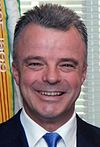
Following the 2007 federal election, Dr
Through 2010, the party remained in opposition at the
In March 2013, the Western Australian Liberal-National government won re-election, and
Abbott, Turnbull and Morrison governments
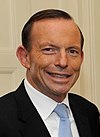
The party won government in Tasmania in 2014 and lost their fourth election in a row at the South Australian election. However, the Victorian Liberal-National government, now led by Denis Napthine, became the first one term government in Victoria in 60 years. Similarly, just two months later, the Liberal National government in Queensland was defeated just three years after its historic landslide victory. The New South Wales Liberal-National Coalition, however, managed to win re-election in March 2015. In 2016 the Federal Liberals narrowly won re-election in July 2016 while the Liberal-affiliated Country Liberals suffered a historic defeat in the Northern Territory and Canberra Liberals lost their fifth election in a row in October 2016. The Liberals fared little better in 2017 with the Barnett-led Liberal-National government in Western Australia also suffered a landslide defeat in March.
Abbott government
Turnbull government
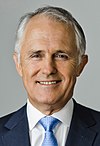
Turnbull's time in office saw tensions between Moderate and Conservative factions within the Liberal Party.[72]
On 21 August 2018 after a week of mounting pressure on Turnbull's leadership over his handling of energy policy and election strategy, the prime minister used the regular party-room meeting to spill the party leadership in an attempt to head off a growing conservative-led move against him by Home Affairs Minister Peter Dutton.[citation needed] Turnbull survived the challenge, winning 48 votes to Dutton's 35. A further spill was called by Turnbull, in which he declined to stand and the leadership of the party was decided in favour of Treasurer Scott Morrison, over Dutton.[citation needed]
Morrison government
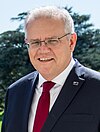
In August 2018, Home Affairs Minister Peter Dutton unsuccessfully challenged Turnbull for the leadership of the Liberal Party. Leadership tension continued, and the party voted to hold a second leadership ballot on 24 August, with Turnbull choosing not to stand. In that ballot, Morrison was seen as a compromise candidate and defeated both Dutton and Foreign Minister Julie Bishop to become leader of the Liberal Party. He was sworn in as prime minister by the governor-general later that day. Morrison went on to lead the Coalition to an unexpected victory in the 2019 election.
2022 outcome

In the 2022 election, the Liberal Party lost control of the Australian Parliament.[74] During the election, which also saw Morrison resign as Liberal Leader and Liberal Deputy Leader Josh Frydenberg lose his seat in Parliament, the Liberal Party lost what was determined to be the most significant number of seats since the Party's creation in 1944.[75][74] The departure of Morrison and Frydenberg's defeat made recent Leader of the House and Minister for Defence Peter Dutton the only viable candidate to become the next Liberal Party leader.[76][77]
Dutton is the first Liberal leader to come from Queensland, and the first leader since Alexander Downer in 1995 to represent a seat outside of New South Wales.
Ideology and factions
| This article is part of a series on |
| Liberalism in Australia |
|---|
 |
| This article is part of a series on |
| Conservatism in Australia |
|---|
 |
| Timeline of liberal parties |
|
| Faction | Ideology | Political position | Leader | Members |
|---|---|---|---|---|
| Moderate | Centre to centre-right | Simon Birmingham | 13 / 63
| |
| Centrist | Centre to centre-right | — | 11 / 63
| |
| Centre Right | Centre-right | Alex Hawke | 5 / 63
| |
| National Right | Right-wing | Peter Dutton | 27 / 63
| |
| Independent[d] | — | — | — | 7 / 63
|
During the Morrison government years, the Liberal Party consisted of three broad factional groupings: a moderate wing, a centre-right wing and a right wing, led by Simon Birmingham, Scott Morrison and Peter Dutton respectively, with the Centre-Right being the largest faction, with 32 of 91 Liberal MPs belonging to the group.[78] The 2022 Australian federal election saw a significant realignment of factional affiliations within the Liberal Party: the National Right became the largest faction with 27 of 65 Liberal MPs aligned with the faction, the Centre-Right went from being the largest faction to the smallest faction, plummeting from 32 members to just 6, the Moderates' membership dropped from 22 members to 14, while a Centrist faction emerged, comprising 11 members.[79]
The Liberal Party generally advocates conservative policies[16] including economic liberalism. Historically, the party has supported a higher degree of economic protectionism and interventionism than it has in recent decades. However, from its foundation the party has identified itself as an anti-socialist grouping of liberals and conservatives.[12] Strong opposition to socialism and communism in Australia and abroad was one of its founding principles. The party's founder and longest-serving leader Robert Menzies envisaged that Australia's middle class would form its main constituency.
Towards the end of his term as Prime Minister of Australia and in a final address to the Liberal Party Federal Council in 1964, Menzies spoke of the "Liberal Creed" as follows:
As the etymology of our name "Liberal" indicates, we have stood for freedom... We took the name 'Liberal' because we were determined to be a progressive party, willing to make experiments, in no sense reactionary but believing in the individual, his right and his enterprise, and rejecting the socialist panacea. We have realised that men and women are not just ciphers in a calculation, but are individual human beings whose individual welfare and development must be the main concern of government ... We have learned that the right answer is to set the individual free, to aim at equality of opportunity, to protect the individual against oppression, to create a society in which rights and duties are recognised and made effective.
— Robert Menzies[80]
Soon after the election of the Howard government the new Prime Minister John Howard, who was to become the second-longest serving Liberal Prime Minister, spoke of his interpretation of the "Liberal Tradition" in a Robert Menzies Lecture in 1996:
Menzies knew the importance for Australian Liberalism to draw upon both the classical liberal as well as the conservative political traditions. He believed in a liberal political tradition that encompassed both Edmund Burke and John Stuart Mill—a tradition which I have described in contemporary terms as the broad church of Australian Liberalism.
— John Howard[80]
Until the 2022 election, the Liberals were in electoral terms largely the party of the middle class (whom Menzies, in the era of the party's formation called "
Menzies was an ardent
Domestically, Menzies presided over a fairly regulated economy in which utilities were publicly owned, and commercial activity was highly regulated through centralised wage-fixing and high tariff protection. Liberal leaders from Menzies to Malcolm Fraser generally maintained Australia's high tariff levels. At that time the Liberals' coalition partner, the Country Party, the older of the two in the coalition (now known as the "National Party"), had considerable influence over the government's economic policies. It was not until the late 1970s and through their period out of power federally in the 1980s that the party came to be influenced by what was known as the "New Right"—a conservative liberal group who advocated market deregulation, privatisation of public utilities, reductions in the size of government programs and tax cuts.
Socially, while liberty and freedom of enterprise form the basis of its beliefs, elements of the party include both what is termed "small-l liberalism" and social conservatism. Historically, Liberal governments have been responsible for the carriage of a number of notable "socially liberal" reforms, including the opening of Australia to multiethnic immigration under Menzies and
The Prime Minister of Australia, Scott Morrison, stated the following in his 2019 victory speech;[89]
This is, this is the best country in the world in which to live. It is those Australians that we have been working for, for the last five and a half years since we came to Government, under Tony Abbott's leadership back in 2013. It has been those Australians who have worked hard every day, they have their dreams, they have their aspirations; to get a job, to get an apprenticeship, to start a business, to meet someone amazing. To start a family, to buy a home, to work hard and provide the best you can for your kids. To save for your retirement and to ensure that when you're in your retirement, that you can enjoy it because you've worked hard for it. These are the quiet Australians who have won a great victory tonight.
The Liberal Party is a member of the
Organisation
The Liberal Party's organisation is dominated by the six state divisions, reflecting the party's original commitment to a federalised system of government (a commitment which was strongly maintained by all Liberal governments bar the Gorton government until 1983, but was to a large extent abandoned by the Howard government, which showed strong centralising tendencies). Menzies deliberately created a weak national party machine and strong state divisions. Party policy is made almost entirely by the parliamentary parties, not by the party's rank-and-file members, although Liberal party members do have a degree of influence over party policy.[91]
The Liberal Party's basic organisational unit is the branch, which consists of party members in a particular locality. For each electorate there is a conference—notionally above the branches—which coordinates campaigning in the electorate and regularly communicates with the member (or candidate) for the electorate. As there are three levels of government in Australia, each branch elects delegates to a local, state, and federal conference.[91]
All the branches in an Australian state are grouped into a Division. The ruling body for the Division is a State Council. There is also one Federal Council which represents the entire organisational Liberal Party in Australia. Branch executives are delegates to the Councils ex-officio and additional delegates are elected by branches, depending on their size.[91]
Preselection of electoral candidates is performed by a special electoral college convened for the purpose. Membership of the electoral college consists of head office delegates, branch officers, and elected delegates from branches.[91]
Federal parliamentary leaders
State and territory divisions
| Branch | Leader | Last election | Status | Federal MPs | ||||||||
|---|---|---|---|---|---|---|---|---|---|---|---|---|
| Lower House | Upper House | |||||||||||
| Year | Votes (%) | Seats | TPP (%) | Votes (%) | Seats | |||||||
| New South Wales Liberals | Mark Speakman (since 2023)[e] | 2023 | 26.78 | 25 / 93
|
45.73[f] | 29.78[f] | 10 / 42
|
Opposition (Liberal–National Coalition) | 13 / 59
| |||
| Liberal Victoria | John Pesutto (since 2022)[g] | 2022 | 29.76 | 19 / 88
|
45.00[h] | 29.44[h] | 14 / 40
|
Opposition (Liberal–National Coalition) | 9 / 51
| |||
| Liberal National[i] | David Crisafulli (since 2020)[j] | 2020 | 35.89 | 34 / 93
|
46.8 | —[k] | Opposition | 26 / 42
| ||||
| Western Australian Liberals | Libby Mettam (since 2023) | 2021 | 21.30 | 2 / 59
|
30.32[l] | 17.68 | 7 / 36
|
Opposition (National–Liberal Alliance) | 10 / 27
| |||
| South Australian Liberals | David Speirs (since 2022)[m] | 2022 | 35.67 | 16 / 47
|
45.41 | 34.38 | 8 / 22
|
Opposition | 9 / 22
| |||
| Tasmanian Liberals | Jeremy Rockliff (since 2022) | 2024 | 36.67 | 14 / 35
|
—[n] | —[o] | 4 / 15
|
Minority government
|
6 / 17
| |||
| Canberra Liberals | Elizabeth Lee (since 2020)[p] | 2020 | 33.8 | 9 / 25
|
—[q] | —[r] | Opposition | 0 / 5
| ||||
| Country Liberal[s] | Lia Finocchiaro | 2020 | 31.34 | 8 / 25
|
46.70 | —[t] | Opposition | 1 / 4
| ||||
Federal presidents
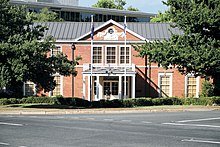
Networks and party wings
The Liberal Party has several party wings and networks. Major party wings include:
- The Australian Liberal Student's Federation(the students' wing)
- The Federal Women's Committee (the women's wing)
- The Young Liberals (the youth wing)
Other networks include an overseas wing (Australian Liberals Abroad)[9] and a Norfolk Island wing (operated by the Canberra Liberals).[92]
Federal election results
House of Representatives
| Election | Seats won | ± | Total votes | Share of votes | Position | Party Leader |
|---|---|---|---|---|---|---|
| 1946 | 15 / 74
|
1,241,650 | 28.58% | Opposition | Robert Menzies | |
| 1949 | 55 / 121
|
1,813,794 | 39.39% | Majority gov't (LP-CP) | ||
| 1951 | 52 / 121
|
1,854,799 | 40.62% | Majority gov't (LP-CP) | ||
| 1954 | 47 / 121
|
1,745,808 | 38.31% | Majority gov't (LP-CP) | ||
| 1955 | 57 / 122
|
1,746,485 | 39.73% | Majority gov't (LP-CP) | ||
| 1958 | 58 / 122
|
1,859,180 | 37.23% | Majority gov't (LP-CP) | ||
| 1961 | 45 / 122
|
1,761,738 | 33.58% | Majority gov't (LP-CP) | ||
| 1963 | 52 / 122
|
2,030,823 | 37.09% | Majority gov't (LP-CP) | ||
| 1966 | 61 / 124
|
2,291,964 | 40.14% | Majority gov't (LP-CP) | Harold Holt | |
| 1969 | 46 / 125
|
2,125,987 | 34.77% | Majority gov't (LP-CP) | John Gorton | |
| 1972 | 38 / 125
|
2,115,085 | 32.04% | Opposition | William McMahon | |
| 1974 | 40 / 127
|
2,582,968 | 34.95% | Opposition | Billy Snedden | |
| 1975 | 68 / 127
|
3,232,159 | 41.80% | Majority gov't (LP-NP) | Malcolm Fraser | |
| 1977 | 67 / 124
|
3,017,896 | 38.09% | Majority gov't (LP-NP) | ||
| 1980 | 54 / 125
|
3,108,512 | 37.43% | Majority gov't (LP-NP) | ||
| 1983 | 33 / 125
|
2,983,986 | 34.36% | Opposition | ||
| 1984 | 45 / 148
|
2,951,556 | 34.06% | Opposition | Andrew Peacock | |
| 1987 | 43 / 148
|
3,175,262 | 34.41% | Opposition | John Howard | |
| 1990 | 55 / 148
|
3,468,570 | 35.04% | Opposition | Andrew Peacock | |
| 1993 | 49 / 147
|
3,923,786 | 37.10% | Opposition | John Hewson | |
| 1996 | 75 / 148
|
4,210,689 | 38.69% | Majority gov't (LP-NP) | John Howard | |
| 1998 | 64 / 148
|
3,764,707 | 33.89% | Majority gov't (LP-NP) | ||
| 2001 | 68 / 150
|
4,244,072 | 37.40% | Majority gov't (LP-NP) | ||
| 2004 | 74 / 150
|
4,741,458 | 40.47% | Majority gov't (LP-NP-CLP) | ||
| 2007 | 55 / 150
|
4,546,600 | 36.60% | Opposition | ||
| 2010 | 60 / 150 [note 3]
|
3,777,383 | 30.46% | Opposition | Tony Abbott | |
| 2013 | 74 / 150 [note 4]
|
4,134,865 | 32.02% | Majority gov't (LP-NP) | ||
| 2016 | 60 / 150 [note 3]
|
3,882,905 | 28.67% | Majority gov't (LP-NP) | Malcolm Turnbull | |
| 2019 | 61 / 151 [note 3]
|
3,989,435 | 27.97% | Majority gov't (LP-NP) | Scott Morrison | |
| 2022 | 42 / 151 [note 3]
|
3,502,713 | 23.89% | Opposition |
Donors
For the 2015–2016 financial year, the top ten disclosed donors to the Liberal Party were: Paul Marks (Nimrod resources) ($1,300,000),
The Liberal Party also receives undisclosed funding through several methods, such as "associated entities". Cormack Foundation,[95] Eight by Five, Free Enterprise Foundation, Federal Forum and Northern Sydney Conservative forum are entities which have been used to funnel donations to the Liberal Party without disclosing the source.[96][97][98]
See also
- Country Liberal Party (Northern Territory)
- Liberal National Party (Queensland)
- Liberal Party of Australia (New South Wales Division)
- Liberal Party of Australia (South Australian Division)
- Liberal Party of Australia (Tasmanian Division)
- Liberal Party of Australia (Victorian Division)
- List of political parties in Australia
- Turnbull Government
- Abbott Government
- Liberalism in Australia
- Moderates
- Young Liberal Movement of Australia
Notes
- ^ Menzies is the party's most prominent co-founder, having been the party's first and longest serving leader. Furthermore, he is often cited as the "founder"[2] or "father" of the party.[3][4]
- ^ The Liberal Party acknowledges the party's formation date to be 13 October 1944,[5] which was the first day of a three-day meeting called the "Conference of Representatives of Non-Labour Organisations" in Canberra.[6][7][8] The name and objectives were adopted at the conference, with the party constitution and organisation being decided two months later at the Albury Conference (15–16 December 1944). The only other date that has been cited for the founding of the party is 31 August 1945.
- ^ The Liberal National Party of Queensland was formed as a merger of the Queensland branch of the Liberal Party and the National Party. It mainly functions at the state-level.
- ^ Includes all unknown, unaligned or faction-less members.
- ^ Post-2023 state election.
- ^ a b Combined with the New South Wales Nationals.
- ^ Post-2022 state election.
- ^ a b Combined with the Victorian Nationals.
- Queensland National partyto contest elections as a single party.
- ^ Post-2020 state election.
- ^ Queensland has maintained a unicameral legislature since 1922.
- ^ Combined with the WA Nationals.
- ^ Post-2022 state election
- ^ Tasmania uses a semi-proportional system and thus TPP is not calculated.
- ^ Tasmania elects legislative council representatives on a periodic basis, with elections held almost every year.
- ^ Post-2020 territory election
- ^ The ACT uses a semi-proportional system and thus TPP is not calculated.
- ^ The ACT has a unicameral parliament.
- ^ The Country Liberal Party is endorsed as the Northern Territory division of the Liberal Party
- ^ The Northern Territory has a unicameral parliament.
References
- ^ "Political party name abbreviations & codes, demographic ratings and seat status". Australian Electoral Commission. 18 January 2016. Archived from the original on 26 May 2022. Retrieved 8 September 2018.
- ^ Brandis, George (24 October 2022). "Taking liberties with Menzies' politics betrays his life and legacy". The Sydney Morning Herald. Archived from the original on 15 November 2022. Retrieved 6 January 2023.
One of the most important differences between the Liberal Party and the Labor Party is a historical one. Labor traces its roots to the trade union movement of the late 19th century; it does not point to any one great figure as its founder. The Liberal Party, by contrast, is unquestionably the creation of a single man, Robert Menzies – its founder and longest-serving leader and Australia's longest-serving prime minister. Both sides of politics acknowledge this: Paul Keating, in a savage speech, once spoke of his desire "to destroy Menzies' creation".
- ^ Hutchens, Gareth (3 October 2021). "Robert Menzies wouldn't recognise the Liberal Party's employment policies today". ABC News. Archived from the original on 6 January 2023. Retrieved 6 January 2023.
It's why the "father" of the Liberal Party, Robert Menzies, would hardly recognise his party's economic policies today.
- ^ Walker, Tony (28 August 2018). "Malcolm Fraser's political manifesto would make good reading for the Morrison government". The Conversation. Archived from the original on 6 January 2023. Retrieved 6 January 2023.
Menzies' "forgotten people" were defined as those caught between a union-dominated Labor Party and a conservative establishment. What the father of the Liberal Party had in mind was the artisan and small business class, broadly defined.
- ^ "Our History". liberal.org.au. Liberal Party of Australia. 12 June 2013. Archived from the original on 25 October 2022. Retrieved 31 December 2022.
- ^ a b "Forming the Liberal Party of Australia – Record of the Conference of Representatives of Non-Labor Organisations" (PDF). 16 October 1944. Archived (PDF) from the original on 27 November 2019. Retrieved 27 November 2019.
- ^ a b "Formation of the Liberal Party of Australia". Party History. Liberal Party of Australia—Queensland Division. Archived from the original on 26 April 2007. Retrieved 11 April 2007.
- ^ a b c d Ian Hancock. "The Origins of the Modern Liberal Party". Harold White Fellowships. National Library of Australia. Archived from the original on 6 June 2011. Retrieved 11 April 2007.
- ^ a b "Australian Liberals Abroad". 12 June 2013.
- ^ "Our Structure". Liberal Party of Australia. 12 June 2013. Archived from the original on 18 May 2019. Retrieved 27 February 2023.
- ^ Davies, Anne (13 December 2020). "Party hardly: why Australia's big political parties are struggling to compete with grassroots campaigns". The Guardian. Archived from the original on 22 July 2022. Retrieved 28 March 2021.
- ^ a b Hancock, Ian (1994). "The Origins of the Modern Liberal Party". Archived from the original on 6 June 2011. Retrieved 4 September 2021.
History of Liberalism in Australia
- ^ Steketee, Mike (12 March 2021). "The revolt of the Liberal moderates". The Canberra Times. Archived from the original on 26 April 2022. Retrieved 26 April 2022.
- ISBN 9780868409917.
- ISBN 9780521672832. Archivedfrom the original on 26 March 2023. Retrieved 19 March 2023.
The ideology of the Liberal Party has in fact always been a mixture of conservatism, social liberalism and classical or neo-liberalism ...
- ^ from the original on 4 September 2021. Retrieved 4 September 2021.
- ^ Massola, James (20 March 2021). "Who's who in the Liberals' left, right and centre factions?". The Sydney Morning Herald. Archived from the original on 22 March 2021. Retrieved 26 April 2022.
- PMID 22567166.
The Liberal Party of Australia has an ideology in line with liberal conservatism and is therefore right of centre.
- ^ Massola, James (20 March 2021). "Who's who in the Liberals' left, right and centre factions?". The Sydney Morning Herald. Archived from the original on 22 March 2021. Retrieved 26 April 2022.
- ^ Massola, James (20 March 2021). "Who's who in the Liberals' left, right and centre factions?". The Sydney Morning Herald. Archived from the original on 22 March 2021. Retrieved 26 April 2022.
- ^ Massola, James (20 March 2021). "Who's who in the Liberals' left, right and centre factions?". The Sydney Morning Herald. Archived from the original on 22 March 2021. Retrieved 26 April 2022.
- ^ Bourke, Latika (19 January 2018). "'Arrogantly ignored': Right-wing Liberals hit back at Ruddock 'unity' ticket". The Sydney Morning Herald. Nine Entertainment. Archived from the original on 12 February 2019.
- ^ Patrick, Aaron (2 April 2023). "Conservatives used to think Aston was the Liberals' future". Australian Financial Review. Nine Entertainment. Archived from the original on 3 April 2023.
- ^ Massola, James (9 April 2023). "How Morrison's shattering defeat gave Dutton a seismic shift in factional power". The Sydney Morning Herald. Nine Entertainment. Archived from the original on 10 April 2023.
- ^ Pimenta, David (10 November 2023). "Two sides of the same 'West': the radical right wing in Australia and Portugal". theloop.ecpr.eu. European Political Science Review.
- ^ Ferguson, Richard (14 April 2021). "Liberals' flag fiasco". The Australian. Archived from the original on 31 December 2022. Retrieved 31 December 2022.
- ^ Wilkinson, Jamie (27 June 2016). "A short history of political party branding – Liberals". news.canningspurple.com.au. Archived from the original on 13 January 2023. Retrieved 13 January 2023.
- ISBN 978-1-137-51733-3. Archivedfrom the original on 24 January 2023. Retrieved 9 August 2020.
- ^ "Interview with Barrie Cassidy, Insiders, ABC". Liberal Party of Australia. 28 August 2016. Archived from the original on 24 July 2018. Retrieved 16 June 2017.
- ^ corporateName=Commonwealth Parliament; address=Parliament House, Canberra. "Infosheet 22 - Political parties". www.aph.gov.au. Archived from the original on 11 March 2023. Retrieved 3 April 2023.
{{cite web}}: CS1 maint: multiple names: authors list (link) - ^ "Our structure". Liberal Party of Australia. Archived from the original on 18 May 2019. Retrieved 30 August 2020.
There is one Division for each of the six states, as well as the Australian Capital Territory. The Northern Territory Country Liberal Party is an affiliate of the Liberal Party. Each of the Liberal Party's seven Divisions is autonomous and has their own constitutions.
- ISBN 978-1-4616-7175-6. Archivedfrom the original on 26 March 2023. Retrieved 9 November 2015.
- PMID 22567166.
The Liberal Party of Australia has an ideology in line with liberal conservatism and is therefore right of centre.
- ISBN 978-1-137-31484-0. Archivedfrom the original on 26 March 2023. Retrieved 9 November 2015.
- ISBN 978-1-4616-7175-6. Archivedfrom the original on 26 March 2023. Retrieved 15 September 2020.
- ISBN 978-1-55130-412-0. Archivedfrom the original on 26 March 2023. Retrieved 9 November 2015.
- ^ "Before office—Joseph Lyons—Australia's PMs—Australia's Prime Ministers". Primeministers.naa.gov.au. Archived from the original on 20 March 2020. Retrieved 21 June 2012.
- ^ ""Democratic Party" Formed". The Sydney Morning Herald. 25 November 1943. Archived from the original on 3 August 2020. Retrieved 29 November 2019.
- ^ John Laverty, 'Chandler, Sir John Beals (1887–1962)', Australian Dictionary of Biography, National Centre of Biography, Australian National University, http://adb.anu.edu.au/biography/chandler-sir-john-beals-9724/text17171 Archived 3 August 2020 at the Wayback Machine, published first in hardcopy 1993. Retrieved 22 June 2018.
- ^ "Menzies' Forgotten People Speech—Australian History, Australian Prime Ministers". Dl.nfsa.gov.au. Archived from the original on 4 March 2021. Retrieved 21 June 2012.
- ^ "The Forgotten People—Speech by Robert Menzies on 22 May 1942. Liberals.Net: Liberal Party of Australia". Liberals.net. 22 May 1942. Archived from the original on 3 March 2021. Retrieved 21 June 2012.
- ^ "Our History—Liberal Party of Australia". Liberal.org.au. 16 October 1944. Archived from the original on 28 July 2012. Retrieved 21 June 2012.
- ^ "Liberal Democratic Party dissolved". Newcastle Morning Herald and Miners' Advocate. 16 January 1945. Archived from the original on 3 August 2020. Retrieved 2 December 2019.
- ^ "Liberal Party – Parliamentary Section Formed". National Advocate. 21 April 1945. Archived from the original on 3 August 2020. Retrieved 2 December 2019.
- ^ Brian Carroll; From Barton to Fraser; Cassell Australia; 1978
- ^ "Elections – Robert Menzies – Australia's PMs – Australia's Prime Ministers". Primeministers.naa.gov.au. Archived from the original on 12 May 2016. Retrieved 21 June 2012.
- ^ "Australian Biography: Bob Santamaria". National Film and Sound Archive. Archived from the original on 18 February 2022. Retrieved 20 February 2022.
- ^ "ABC The Drum – Conviction? Clever Kevin is no Pig Iron Bob". Australian Broadcasting Corporation. 30 April 2010. Archived from the original on 23 June 2011. Retrieved 21 June 2012.
- ^ A. W. Martin. "Menzies, Sir Robert Gordon (Bob) (1894–1978)". Biography – Sir Robert Gordon (Bob) Menzies – Australian Dictionary of Biography. Adb.online.anu.edu.au. Archived from the original on 26 March 2023. Retrieved 21 June 2012.
- ^ "The way we were: quiet, maybe, but certainly not dull". The Sydney Morning Herald. 26 April 2011. Archived from the original on 30 August 2011. Retrieved 1 February 2012.
- ^ Jan Bassett (1986) p.273
- ^ Frank Crowley p.358
- ^ "Electoral Milestones – Timetable for Indigenous Australians – Australian Electoral Commission". aec.gov.au. Archived from the original on 30 June 2011. Retrieved 21 June 2012.
- ^ "Elections – Harold Holt – Australia's PMs – Australia's Prime Ministers". Primeministers.naa.gov.au. Archived from the original on 26 June 2012. Retrieved 21 June 2012.
- ^ "In office – Harold Holt – Australia's PMs – Australia's Prime Ministers". Primeministers.naa.gov.au. Archived from the original on 15 March 2011. Retrieved 21 June 2012.
- ^ a b "In office – John Gorton – Australia's PMs – Australia's Prime Ministers". Primeministers.naa.gov.au. Archived from the original on 26 October 2022. Retrieved 21 June 2012.
- ^ "In office – William McMahon – Australia's PMs – Australia's Prime Ministers". Primeministers.naa.gov.au. Archived from the original on 15 March 2011. Retrieved 21 June 2012.
- ^ a b "Timeline – Australia's Prime Ministers". Primeministers.naa.gov.au. Archived from the original on 4 August 2017. Retrieved 21 June 2012.
- ^ "Civics | Neville Bonner (1922–1999)". Curriculum.edu.au. Archived from the original on 30 April 2012. Retrieved 21 June 2012.
- ^ "After office – John Gorton – Australia's PMs – Australia's Prime Ministers". Primeministers.naa.gov.au. Archived from the original on 16 November 2010. Retrieved 21 June 2012.
- ^ "Malcolm Fraser". www.nma.gov.au. National Museum of Australia. Archived from the original on 9 August 2019. Retrieved 20 September 2019.
- ^ "In office – Malcolm Fraser – Australia's PMs – Australia's Prime Ministers". Primeministers.naa.gov.au. Archived from the original on 15 March 2011. Retrieved 21 June 2012.
- ^ "Robert Hawke – Australia's PMs – Australia's Prime Ministers". Primeministers.naa.gov.au. Archived from the original on 17 November 2010. Retrieved 21 June 2012.
- ^ "In office – Paul Keating – Australia's PMs – Australia's Prime Ministers". Primeministers.naa.gov.au. Archived from the original on 2 December 2010. Retrieved 21 June 2012.
- ^ "Transcript of the Prime Ministerthe Hon John Howard Mpaddress to the Lowy Institute For International Policy". Au.chineseembassy.org. Archived from the original on 8 February 2015. Retrieved 21 June 2012.
- ^ "The Poll Vault: Can do Campbell now the Libs man". Archived from the original on 28 November 2007.
- ^ Hudson, Phillip (16 September 2008). "Get behind Turnbull: Nelson tells Libs". The Sydney Morning Herald. Archived from the original on 18 January 2018. Retrieved 16 February 2009.
- ^ Shock win for Abbott in leadership vote Archived 24 November 2010 at the Wayback Machine, Australian Broadcasting Corporation, 1 December 2009.
- ^ "Voters leave Australia hanging Archived 24 August 2010 at the Wayback Machine" ABC News, 21 August 2010
- ^ "Bleakest hour is one for the history books". The Sydney Morning Herald. 28 March 2011. Archived from the original on 29 August 2011. Retrieved 29 March 2011.
- ^ "LNP Celebrate Campbell Newman Queensland Election Victory". Brisbane Time. 24 March 2012. Archived from the original on 12 July 2012. Retrieved 21 June 2012.
- ^ Johnson, Carol (18 November 2016). "Pressure on Malcolm Turnbull to bend to conservatives is stronger than ever". The Conversation. Archived from the original on 4 March 2022. Retrieved 4 March 2022.
- ^ "Scott Morrison sworn in as Prime Minister". The Sydney Morning Herald. 24 August 2018. Archived from the original on 24 August 2018. Retrieved 27 August 2018.
- ^ a b "Live: Morrison calls Albanese to concede electoral defeat as Labor, independents unseat Coalition". ABC News. 21 May 2022. Archived from the original on 21 May 2022. Retrieved 21 May 2022.
- ^ Maiden, Samantha (21 May 2022). "Liberals in crisis after Josh Frydenberg loses seat in election chaos". Australian Broadcast Corporation. Retrieved 21 May 2022.
- ^ Saunokonoko, Mark (21 May 2022). "'Last man standing' Dutton tipped to lead Liberal Party after election rout". Nine News. Archived from the original on 21 May 2022. Retrieved 22 May 2022.
- ^ Massola, James (22 May 2022). "Peter Dutton poised to be next opposition leader after Scott Morrison steps down". Sydney Morning Herald. Archived from the original on 21 May 2022. Retrieved 22 May 2022.
- ^ Massola, James (21 March 2021). "Who's who in the Liberals' left, right and centre factions?". The Sydney Morning Herald. Fairfax Media. Archived from the original on 22 March 2021. Retrieved 1 February 2022.
- ^ Massola, James (8 April 2023). "How Morrison's shattering defeat gave Dutton a seismic shift in factional power". The Sydney Morning Herald. Retrieved 4 December 2023.
- ^ a b "We believe: the Liberal party and the liberal cause". The Australian. 26 October 2009.[permanent dead link]
- ^ Simms, Robert. "The Australian Greens and the Moral Middle Class" (PDF). Australian Political Studies Association. Archived from the original (PDF) on 17 March 2020. Retrieved 21 June 2018.
- ^ Hollander, Robyn (2008). "John Howard, Economic Liberalism, Social Conservatism and Australian Federalism". Australian Journal of Politics and History. Archived from the original on 3 August 2020. Retrieved 21 June 2018.
- ^ "Liberals still dominate the top end – Mumble". 7 December 2010. Archived from the original on 28 June 2012. Retrieved 29 November 2012.
- ^ "'The people who need a voice are those hit by rise in power prices': John Roskam". Msn.com. 23 May 2022. Archived from the original on 8 June 2022. Retrieved 8 June 2022.
- ^ "Fact sheets – National Archives of Australia". Naa.gov.au. 27 May 1967. Archived from the original on 4 November 2010. Retrieved 27 April 2010.
- ^ "Chronology 1960s – ASO". Australianscreen.com.au. Archived from the original on 22 March 2009. Retrieved 27 April 2010.
- ^ "ABC News Obituary – Neville Bonner". Australian Broadcasting Corporation. Archived from the original on 28 March 2010. Retrieved 27 April 2010.
- ^ "Ken Wyatt | Hasluck". The Sydney Morning Herald. 23 August 2010. Archived from the original on 7 November 2012. Retrieved 1 February 2011.
- ^ "Speech Sydney". Prime Minister of Australia. 18 May 2019. Archived from the original on 28 December 2020. Retrieved 23 May 2019.
- ^ "International Democracy Union - Asia Pacific Democrat Union (APDU)". International Democracy Union. 2016. Archived from the original on 16 June 2017. Retrieved 12 June 2017.
- ^ a b c d "Our Structure". 12 June 2013. Archived from the original on 7 May 2016. Retrieved 17 May 2014.
- ^ "Join the Party | Canberra Liberals". Archived from the original on 28 November 2022. Retrieved 21 September 2023.
- ^ "Donor Summary by Party Group". periodicdisclosures.aec.gov.au. Archived from the original on 31 August 2017. Retrieved 6 September 2017.
- ^ "Donor Summary by Party". periodicdisclosures.aec.gov.au. Archived from the original on 20 September 2017. Retrieved 6 September 2017.
- ^ "Liberal Party's Victorian branch takes biggest donor to court". The Age. Retrieved 23 November 2017.[permanent dead link]
- ^ "Australian political donations: Who gave how much?". Australian Broadcasting Corporation. 24 October 2016. Archived from the original on 2 April 2020. Retrieved 7 September 2017.
- ^ "ICAC findings into Liberal Party slush fund Eight By Five, illegal donations to be handed down". Australian Broadcasting Corporation. 29 August 2016. Archived from the original on 6 September 2017. Retrieved 7 September 2017.
- ^ "Investigations close into political donations made to Liberal Party slush fund, Eightbyfive". Retrieved 7 September 2017.[permanent dead link]
Further reading
- Henderson, Gerard (1994). Menzies' Child: The Liberal Party of Australia 1944–1994, Allen and Unwin, Sydney, New South Wales.
- Jaensch, Dean (1994) The Liberals, Allen and Unwin, Sydney, New South Wales.
- Nethercote, John (ed.)(2001), Liberalism and the Australian Federation, Federation Press, Annandale, New South Wales. ISBN 1-86287-402-6
- Simms, Marian (1982) A Liberal Nation: The Liberal Party and Australian Politics, Hale and Iremonger, Sydney, New South Wales. ISBN 0-86806-033-X
- Starr, Graeme (1980) The Liberal Party of Australia: A Documentary History, Drummond/Heinemann, Richmond, Victoria. ISBN 0-85859-223-1
- Tiver, P.G. (1978), The Liberal Party. Principles and Performance, Jacaranda, Milton, Queensland. ISBN 0-7016-0996-6
External links
- Official website
- Liberal Party of Australia ephemera digitised and held by the National Library of Australia
- Records of the Victorian division of the Liberal Party held at the University of Melbourne Archives
